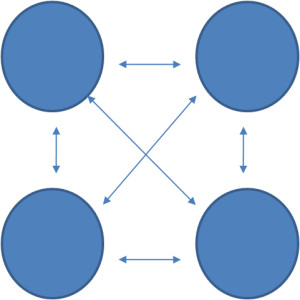

Whether you lead a project, own the product delivery, or involved as a subject matter expert, you are all in the communication business. In this business, effective communication is the most important success factor. And, increasing communication complexity is a major obstacle to ineffective communication.
Now the question is how to discover your project communication complexity? The answer lies in the number of people who are communicating with each other.
Knowing the number of people in the project brings awareness about communication complexity. Say, there are four members in a team: then communication complexity is not about one person is talking to others. It includes 6 (n (n-1)/2) channels by which these four members are communicating with others. It shows that communication complexity is much larger than the number of members in the project. Communication complexity increases as the number of people increases in a project. If there are six members in the team, the number of communication channels rise to 15 (6*5/2)
Earlier I was thinking, calculating communication channels does not seem like a question that needs an entire blog for an answer. A simple formula n (n-1) /2 can do it for you. But I noticed, the number of questions from PMP® exam aspirants popping in our Forum ‘how to calculate communication channels.’ The confusion surrounded by what the value of ‘n’ is. Some part of the confusion attributed to the way PMBOK® Guide defines the value of n and the way practice test puts the case in front of PMP® exam aspirants. In this blog, I will address all these confusions.
As per the PMBOK® Guide,
This statement makes a PMP® exam aspirant think that in this calculation he needs to consider stakeholders. Then while putting the value of n, the test taker starts wondering – does he need to consider Project Manager too. Also is there a need to consider Project team members? The answer is yes; you need to consider whoever allowed communicating with the group. And you need to consider all the entities that get impacted by the project and participate in the communication.
Once during a session one of the test takers asked me: how can I recommend to include PM in the communication channel calculation – As PMBOK® Guide is only referring to stakeholders? I realized then that the problem is bigger which requires immediate attention to the definition of stakeholder:
“An individual, group, or corporation who may change, be affected by, or perceive itself to be affected by a judgment, activity, or outcome of a project.”
Stakeholders include everyone. But many times in projects we refer term stakeholders for people who are affected by project but not form a part of the project team. This practice is quite acceptable, but when we go for an exam, we need to stick to the definition of stakeholders. You may find a question where project team members, project managers, and stakeholders separately identified. You need to include all in calculating communication complexity including the project manager.
Let’s get into the details of the communication channel. In the above four-member example – Instead of using the formula to come up with communication channels, let’s count them from the below communication network.

How many are they? 6? Now see what the formula tells us 4 (4-1) /2 = 4*3/2 = 6
Did you notice the use of this formula? The intent is to communicate the complexity of communication in the numeric term. If you have a high number of communication channels, it is very likely it will result in many communication problems. You may wonder what to do if I have 20 people in the team I will have 20*19/2 = 190 communication channels. For the solution, say you can bring some processes to block some of the communication channels. Like you can create two teams of 9 people where each team communicates inside freely, but for outside they have designated path.

I hope this blog helps you in clearing the doubt related to communication channels. I advise, not to look PMP® exam math questions as a memorization problem, instead, take learning from it for your project management profession.
If you’re getting ready for the PMP Certification, consider enrolling in our all-inclusive PMP Solution program, which provides all the support you need for your PMP Exam in one convenient location. Additionally, we offer a comprehensive free mock test that is regularly updated under the PMI guidelines for the latest exam. Our free mock test can help you evaluate your readiness for the PMP exam.
What is the communication channel in project management?
Answer: Communication channels show the way information flows between stakeholders. Based on the number of people that talk to each other in a project, you calculate the number of communication channels.
We can represent it numerically using n (n – 1) /2 formula.
What are the three main processes in Project communications management?
Answer: There are three processes in the Project Communications Management:
Why is communication important in project management?
Answer: Everything in a project is based on how efficiently we perform communication. It is a vital tool in project management. A project manager spends 90% of the time in project communication. It shows that this is an essential process in the day to day work of project management.
What kind of communication channel related questions are asked in the PMI® exam? Do you have any example?
Answer: In your PMP® exam, you may get questions to confuse you in calculating n for the formula n (n – 1) /2 like:
Can you calculate the number of stakeholders if the number of communication channels is provided in the question?
Answer: You don’t need to worry about it. Your PMP® exam will not ask such questions. As a project manager, you are more concerned about communication complexity which comes from the number of channels. Knowing the number of stakeholders based on communication channels does not make any sense.
As you prepare for the PMP Certification Exam, we’re thrilled to present our latest addition: a set of carefully curated practice questions. Designed to closely reflect the actual PMP exam’s complexity and style, these questions cover key domains including People, Process, and Business Environment, as outlined in the PMP Exam Content Outline (ECO). Each question is complemented by video explanations, offering deeper insights and enhancing your learning experience. Check Out PMP Questions
| Name | Date | Place | – |
| PMP Certification and Training | 13 – 26 April 2025 | Bangalore | More Details |
| PMP Certification and Training | 10 May – 1 June 2025 | Chennai | More Details |